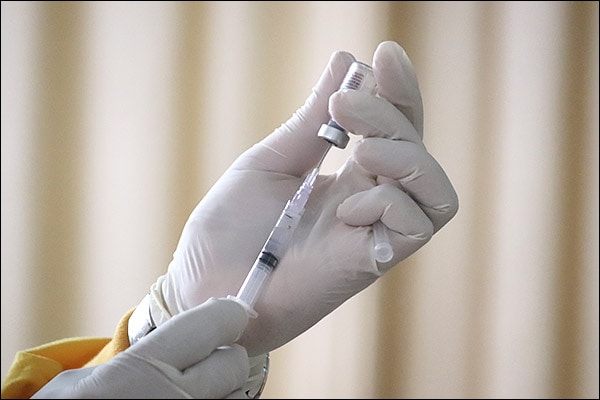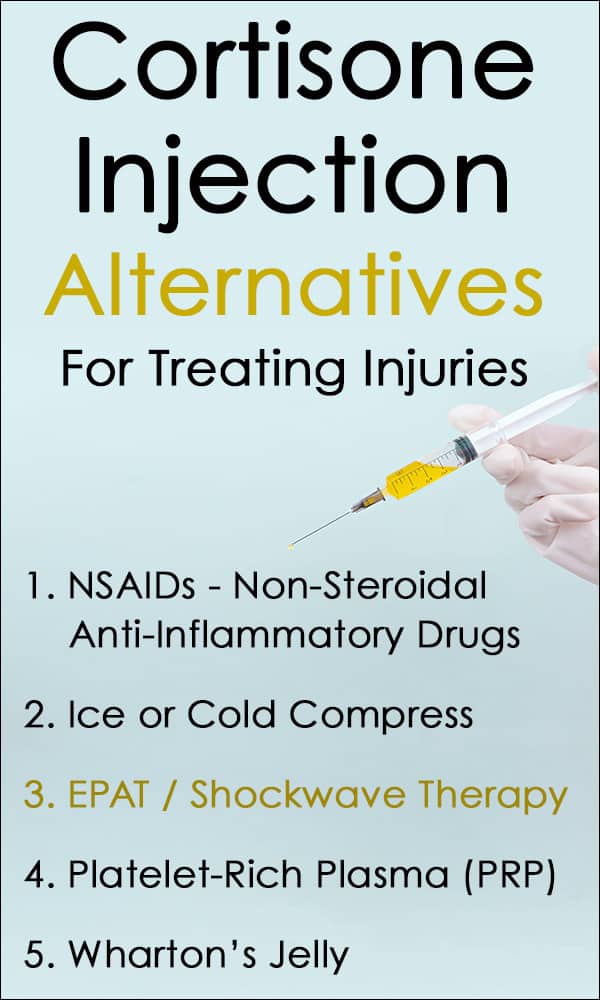For years, getting a steroid shot (corticosteroid) to treat pain and injuries was a common practice used by many sports physicians. However, a lot of patients are now wondering are cortisone injections bad for you?
Steroid injections definitely served a useful purpose at one time, and under certain conditions, are still called for.
Now, though, there are years of evidence showing there may be cortisone injection side effects that might be more harmful than other effective treatment options for pain and injuries.
Understanding what steroids are, what they should and shouldn’t be used for, as well as the potential corticosteroid side effects can help patients suffering from pain or injury make more informed decisions about the healing process.
What is a Cortisone Injection (Steroid Injection)?
Cortisol is a hormone that the body produces on its own. It’s made by the adrenal glands and is released in the body to respond to the stress of injury and illness. It naturally helps decrease inflammation in the body.
Corticosteroids are a synthetic version of cortisol.
Cortisone steroid injections, which are a corticosteroid, not only mimic the all-natural effects of cortisol by decreasing inflammation, but they also help boost the body’s supply of the hormone.
Many people interchangeably use the following terms when describing shots or injections related to injuries:
- Cortisone injection
- Corticosteroid injection
- Steroid Injection

What Are Cortisone Injections Used For?
Corticosteroids are incredibly versatile and useful for some diseases and conditions, especially where inflammation is a factor.
Some good examples are illnesses that affect the immune system, which can include:
- Inflammatory Bowel Disease
- Rheumatoid Arthritis
- Multiple Sclerosis
- Crohn’s Disease
Inflammation is generally a primary symptom of joint-related issues, which is why it’s fairly common to see patients given cortisone injections to help with those conditions.
Cortisone Injections for Common Conditions Include:
- Tendonitis in the Elbows, Wrists, and Other Joints
- Osteoarthritis in the Knee
- Hip Bursitis
- Sciatica
- Frozen Shoulder
It’s easy to confuse cortisone injections with pain relievers, and in fact, corticosteroids are not pain relievers at all. They simply reduce inflammation, which can cause or worsen painful symptoms.
Reducing inflammation to an injured area of the body generally results in a decrease of pain, which is why many people consider cortisone injections a pain reliever.
How long it takes for cortisone injections to reduce inflammation can vary for each person as well as their specific conditions. For some people, the effects of a corticosteroid injection may last many, many months or years.
However, that’s not the case for others, especially those who lead very active lifestyles and return to the same movements or activities that caused an injury in the first place.

What Are Common Cortisone Injection Side Effects?
As with any type of injection, there is always a small risk of infection where the skin is pierced with the needle, although that is rare, especially when administered in a medical setting by professional healthcare worker.
A small number of people are actually allergic to corticosteroids, though again, a true allergy to cortisone is rare.
Most common is a bit of tenderness or soreness at the injection site, which is to be expected.
There are more serious side effects and the risk of these increases with the number of cortisone injections a person gets.
Cortisone Injection Side Effects Can Include:
- Weakening of tendons injected with corticosteroids, as well as nearby tendons. In some cases, this can result in a ruptured or torn tendon.
- Osteoporosis or a thinning of the bones
- Elevated blood pressure
- Thinning of the skin and bruising easily
- Puffy or swollen face, along with weight gain
- Acne on the face, back and shoulders
- Insomnia
- Temporarily high blood sugar, which is why corticosteroids are used with great caution in people with diabetes
What are Some Cortisone Injection Alternatives for Treating Injuries and Inflammation?
Because corticosteroid injections are not free from side effects, especially if administered regularly, it’s important to consider other treatment approaches that reduce swelling and inflammation to decrease injury-related downtime.
Cortisone Injection Alternatives for Treating Injuries
1. Non-Steroidal Anti-Inflammatory Drugs (NSAIDs)
When taken as recommended and in combination with rest and other treatments, Non-Steroidal Anti-Inflammatory Drugs, also known as NSAIDs, are an excellent place to start for treating pain caused by inflammation.
These over-the-counter pain medications like ibuprofen (Advil) and naproxen (Aleve) are effective at reducing inflammation associated with injury.
2. Ice or Cold Compress
Using a cold compress or a simple bag of ice on top of an injured, inflamed joint will slow inflammation and, as a result, can also start to relieve pain.
Used in combination with over-the-counter medicines mentioned above and even elevating the injury, as soon as possible, can help blunt associated inflammation and pain.

3. EPAT / Shockwave Therapy
EPAT Therapy is a non-invasive, highly effective treatment method that uses high or low energy pulsed pressure waves directed into painful or inflamed areas of the body to improve circulation, decrease inflammation, break of up scar tissue, and create new blood vessels. All of these actions increase the speed of healing.
Sometimes referred to as Extracorporeal ShockWave Therapy (ESWT), EPAT Therapy treatments are given in several sessions, with results usually noticeable after one or two sessions. The speed of healing often allows people to return to normal activities more quickly than with other treatment therapies.
4. Platelet-Rich Plasma or PRP Therapy
Platelet-Rich Plasma, or PRP Therapy, can use a person’s own plasma that is injected into injured joints to help reduce inflammation, but more importantly regenerate healthy tissue in the area.
The use of Biologics like PRP in regenerative medicine is now becoming more popular, and the combination of PRP and EPAT Therapy can significantly reduce healing downtime.
5. Wharton’s Jelly
Wharton’s Jelly is a newer treatment approach that is a form of stem cell therapy that when injected helps to reduce pain and inflammation by actually developing into many different types of cells, such as cartilage, tendons and ligaments. This can create healthier and stronger soft-tissue.
Avoiding the Side Effects of Cortisone Injections
Cortisone injections may be the right treatment for some situations, but there are now less invasive treatment approaches, as well as regenerative options that come with fewer side effects and better results.
It’s important to be aware of alternatives, ask questions, and have a discussion with your healthcare provider about making the best choices for long lasting healing and recovery.
Hopefully some of the alternatives to cortisone injections outlined here will offer suggestions to discuss with your doctor or therapist when choosing the most appropriate method for treating the inflammation and pain caused by injuries to get back on track more quickly.